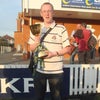The DW Stadium (known as the JJB Stadium before August 2009) is a dual-purpose sports stadium located within the Robin Park retail complex in Wigan, Greater Manchester, opened and built in 1999. The stadium was named after its principal sponsor, the sporting goods retailer JJB Sports—whose former chairman Dave Whelan owns the Wigan Athletic football club. Currently named after the stadium's main sponsor, DW Sports Fitness, the stadium is managed by independent company, Wigan Football Company Limited, and is owned by Wigan Athletic.
Its current capacity is 25,138—seated in four single-tier stands—although its record attendance was in 2008 when 25,133 people witnessed Manchester United play Wigan Athletic in the title-deciding match of the 2007–08 Premier League season. Both football and rugby league matches are played on its grass pitch, and the stadium is home to a team from each sport; Wigan Athletic and Wigan Warriors respectively. Rugby union was also once played at the stadium in the outfit of Orrell RUFC, but the club failed to achieve the success demanded of them and as a result moved out of the stadium in 2003.
Historically, the stadium was first involved in a dispute when it was revealed Dave Whelan had not paid Greater Manchester Police costs for policing football matches. The dispute was settled when the Wigan Athletic club agreed to pay the GB£300,000 owed, although the club later won back damages from the police on appeal. Another dispute emerged when Wigan Warriors had to move their home Super League XIII play-off match against Bradford Bulls to the town of Widnes, after Whelan refused to allow the match to be played due to a scheduled football match at the stadium involving Wigan Athletic the following day.
The stadium has hosted international rugby league games, particularly during the Tri Nations series. Its several lounges and suites also play host to minor musical acts.
The stadium was built by Alfred McAlpine and completed in August 1999. Wigan Athletic had spent the previous 67 years playing at Springfield Park, and their first match at the stadium was a friendly against Morecambe, just before the stadium's official opening.
The stadium's inauguration was marked with a friendly between Wigan Athletic and neighbours Manchester United, who were then reigning European Champions, with Sir Alex Ferguson officially opening the stadium. The first competitive football match there took place on 7 August 1999, with Wigan Athletic facing Scunthorpe United in a Division Two match. Simon Haworth scored twice, including the first competitive goal at the new stadium, as Athletic triumphed 3–0.
The first away team to win a competitive football match at the stadium was Wigan Athletic. A first round FA Cup tie against non-league Cambridge City was played there due to City's ground being deemed unsuitable to host the tie. Wigan played in their changed strip and used the away dressing room since it was technically a 'home' game for Cambridge City. A Stuart Barlow brace secured the win for Wigan.
Wigan RLFC (also known as the Wigan Warriors) moved to the stadium a month after it opened, once they had played their final home game of the 1999 regular season at Central Park. After their former ground was sold, the possibility of ground sharing with Bolton Wanderers F.C. at the modern Reebok Stadium was presented, however, the new stadium in Wigan was chosen instead. Their first game at the stadium was a play-off match against Castleford Tigers, which they lost, on 19 September. Wigan did not lose a competitive match at the stadium in 2001.
Whilst the Wigan Warriors and Wigan Athletic flourished in the new stadium (Wigan Athletic in particular would achieve significant success, rising up the English football pyramid to the Premier League by 2005), the fortunes of Orrell R.U.F.C. could not have been more different. Dave Whelan and Maurice Lindsay decided to invest heavily in the club, with the aim of having the club play in rugby union's Guinness Premiership at the then-JJB Stadium. After failing to win 2004's National Division Two, Whelan pulled a large amount of investment from the club, to a more modest GB£30,000 a year. This was the beginning of Orrell's demise, as players left during the summer of that year and the club were consequently relegated the season after. Ownership eventually passed from Lindsay back to the club's members, but by this point, Orrell had sold their former Edge Hall Road ground to Wigan Warriors and therefore had no assets apart from their rebuilt clubhouse following a fire in 2002. Orrell never settled at the JJB Stadium, and were eventually de-professionalised at the end of the 2006–07 season.
On 7 March 2005 Greater Manchester police announced that they would stop policing Wigan Athletic matches at the stadium from 2 April. This move would almost certainly have resulted in the stadium's safety certificate being revoked, effectively forcing the team to play behind closed doors. The move was part of an ongoing dispute between the police force and Dave Whelan surrounding GB£300,000 in unpaid policing costs. The police's decision would not have affected Wigan RLFC, whose games are stewarded instead of policed. The situation was temporarily resolved on 8 March with both sides reaching an agreement that would allow Athletic to play at the ground until the end of the season. Four months later, Wigan Athletic, facing the prospect of playing their home games in the FA Premier League in an empty stadium, grudgingly paid the money they owed to the police. The club successfully appealed against the payments in court and won damages from the police.
On 7 September 2008, Wigan RLFC revealed plans to take their Super League Play-Off against Bradford Bulls to a neutral venue. The controversial relocation was forced due to a fixture clash, with a match between football clubs Wigan Athletic and Sunderland to take place less than 24 hours after the Super League match. Whelan, who controlled Wigan Athletic, refused permission for the Warriors to stage their elimination at the stadium, citing concerns over the playing surface. The game was relocated to Widnes Vikings home ground, the Stobart Stadium. In the same season, JJB Sports announced they would not continue to sponsor the Wigan Warriors, leaving them without a main shirt sponsor.
The stadium's average attendance has increased significantly since its opening in 1999. The Wigan Warriors' average attendance has increased by 32.5% from its first full season at the stadium in 2000, and Wigan Athletic's average attendance has increased by 181.2% from the 2000–01 season. The highest recorded attendance for a rugby league match is shared between three fixtures; the Wigan Warriors' fixture against St Helens RLFC on 25 March 2005; Game 4 of the 2005 Tri-Nations series between Great Britain and Australia on 6 November; and Game 5 of the 2004 Tri-Nations series between Great Britain and Australia on 13 November at 25,004 each. The highest recorded football attendance at the stadium was Wigan Athletic's home fixture against Manchester United on 11 May 2008—the final day of the 2007–08 Premier League season—with 25,133 fans attending. This is the stadium's highest recorded overall attendance to date, and was the match where Manchester United were crowned Premier League champions for that season.
In March 2009, Dave Whelan acquired a chain of fitness clubs from JJB Sports. In the process, Whelan used the business to set up a new venture, DWSportsfitness and announced that the stadium name would change to the DW Stadium in August. Whelan also announced that at the same time the stadium was renamed, its ownership would pass from himself to Wigan Athletic. Concerns about the future of the Wigan Warriors were arrested in the same announcement, as Whelan extended the lease on the stadium by 50 years for the rugby league team. Before Wigan Warriors' match against Leeds Rhinos in July 2009, both clubs were given the opportunity to rename one stand, with the intention of renaming them in honour to a recognised player from each club's history. The rugby league club were granted the East Stand, which they renamed 'The Boston Stand' in tribute to the Welsh winger Billy Boston, As Wigan Athletic had spent many years in the lower leagues it was recognised that most of their players were not known at national level, so the West Stand was renamed 'The Springfield Stand' after the club's former ground.
| Stand | Capacity |
|---|---|
| North Stand Nameless |
5,418 |
| East Stand The Boston Stand |
8,238 |
| South Stand Nameless |
5,412 |
| West Stand The Springfield Stand |
6,100 |
| Total | 25,168 |
The stadium design is based on cantilevered, prefabricated steel roof and terrace structuring. It is an all-seater arena with a seating capacity of 24,826. The stands are rectangular and both the northern and southern stands have supporting steel girders suspended from beneath the roof. The four stands are of approximately the same height, however the stadium is not totally enclosed, leaving four exposed corners.
At both Wigan Athletic and Wigan RLFC matches, away supporters are situated in the North Stand behind the goal. Occasionally, during games which attract low away support, the 5,418 capacity North Stand is closed altogether, and the away fans who attend are put into an alternative stand. The eastern stand, known as 'The Boston Stand', and the western 'Springfield Stand' run across the longer sides of the pitch. The Boston Stand is the largest, capable of seating up to 8,238 fans and holding an electronic scoreboard. The Springfield Stand contains the stadium's vital facilities; four dressing rooms, benches, a doping control room and a treatment room for the players, as well as four executive boxes, ten radio commentary points and a designated TV studio, in addition to holding 6,100 fans. The North Stand and South Stand have a seating capacity of 5,418 and 5,412 respectively. The stadium also has facilities and access for up to 278 fans with disabilities, with facilities for partially-sighted fans. The seats are a mixture of both resident teams' main colours—red and blue. The stadium is fully compliant with safety guidelines for a sports ground.
The pitch is large enough to conform with both FIFA and the standard rugby league requirements, at 110 by 60 metres (120 yd × 66 yd). This leaves an in-goal area just 5 metres (5.5 yd) deep for rugby matches. It is mostly made of natural grass, with 2% of the pitch composed of synthetics to provide stability. The ground has irrigation, and an under-heating system to resist icy weather.
Wigan RLFC moved from Central Park to the stadium in 1999 after the end of Super League IV's regular season. Since moving to the new stadium, Wigan Warriors' success in rugby league has dropped significantly. Despite being one of the most successful rugby league clubs in England, Wigan have not won a Super League Grand Final since moving to the stadium, and have only won the Challenge Cup once in that time.
| Year | Attendance | |
|---|---|---|
| Average | Highest | |
| 1999 [SL][A] | 13,374 | 13,374 (vs. Castleford Tigers) |
| 2000 [SL] | 11,329 | 19,186 (vs. St Helens RLFC) |
| 2001 [SL] | 11,803 | 21,073 (vs. St Helens RLFC) |
| 2002 [SL] | 10,480 | 18,789 (vs. St Helens RLFC) |
| 2003 [SL] | 11,217 | 21,790 (vs. St Helens RLFC) |
| 2004 [SL] | 13,333 | 20,052 (vs. St Helens RLFC) |
| 2005 [SL] | 13,894 | 25,004 (vs. St Helens RLFC) |
| 2006 [SL] | 14,464 | 18,358 (vs. St Helens RLFC) |
| 2007 [SL] | 16,040 | 24,028 (vs. St Helens RLFC) |
| 2008 [SL] | 13,955 | 19,958 (vs. St Helens RLFC) |
| 2009 [SL] | 14,080 | 22,232 (vs. St Helens RLFC) |
| SL = Super League | ||
Attendances have generally risen for the Wigan Warriors since the start of the 2002 season, averaging around 15,000 over the three seasons from 2006 to 2008. Aside from Grand Finals, the largest Super League attendance was recorded at the stadium in 2005 when Wigan Warriors played their local rivals, St Helens RLFC.
This match is also the highest home attendance in the Wigan
Warriors' history at the stadium. The twenty thousand mark has been
broken ten times since moving to the new stadium in 1999—eight
times against St Helens RLFC, once against local rivals Warrington
Wolves in the opening round of the 2008 Super League season, and
once in July 2009 against the Leeds Rhinos following a campaign
advertising the game as the 'Big One'.
Wigan Athletic's success has improved considerably since their move to the stadium from Springfield Park in 1999. Since 2000, Wigan Athletic have climbed up two divisions and currently play in the FA Premier League.
| Year | Attendance | |
|---|---|---|
| Average | Highest | |
| 2000–01 [L2] | 6,861 | 10,048 (vs. Bristol City F.C.) |
| 2001–02 [L2] | 5,771 | 7,783 (vs. Tranmere Rovers F.C.) |
| 2002–03 [L2] | 7,288 | 12,783 (vs. Oldham Athletic F.C.) |
| 2003–04 [L1] | 9,526 | 20,669 (vs. West Ham United F.C.) |
| 2004–05 [C] | 11,155 | 20,745 (vs. Sunderland F.C.) |
| 2005–06 [PL] | 20,610 | 25,023 (vs. Liverpool F.C.) |
| 2006–07 [PL] | 18,159 | 24,726 (vs. West Ham United F.C.) |
| 2007–08 [PL] | 19,046 | 25,133 (vs. Manchester United F.C.) |
| 2008–09 [PL] | 18,413 | 22,954 (vs. Arsenal F.C.) |
| PL = Premier League, C =
Football League Championship L1 = Football League First Division, L2 = Football League Second Division |
||
Rising success on the pitch has been met with increased attendances. Promotion into the Premier League meant that in their first season of English top-flight football, Wigan Athletic's average home attendance almost doubled from the season before. Over three times more fans attended matches at the stadium during Wigan's 2007–08 season in the Premier League than had attended in the 2001–02 season when Wigan Athletic were in the Football League Second Division. Wigan Athletic's average home attendance for 2007–08 was the lowest out of all 20 teams in the Premier League, failing to make the top 30 English clubs in terms of attendance. The same season saw the highest ever attendance at the stadium, when 25,133 people witnessed Manchester United F.C. play on the final day of the season.
Wigan Athletic's average attendance was again the lowest in the
league for the Premier League 2008–09 season. Premier League
attendances fell on average by around 426 per club during the
2008–09 season. Wigan Athletic's home attendance fell by more than
this, with their average attendance for the 2008–09 season falling
by 633 from the season before. The highest attendance at the
stadium for this season was a match between Wigan Athletic and
Arsenal F.C., in which 22,954 people were counted. This attendance
was 2,357 fans lower than the highest attendance in the season
before.
against New Zealand, played at the stadium in 2007]]
The stadium's numerous lounges provide a venue for small musical acts to perform, and the stadium plays host to minor bands and tribute acts. They are also available to book for private parties. During match days, bands may provide pre-match entertainment on the pitch.
As well as the fixtures for the two domestic teams, the stadium is a venue for international rugby league. Since the stadium's construction in 1999, it has been an ever-present venue whenever the Rugby League Tri-Nations series has been played in England. Its first involvement came during the 2004 series, where the home Great Britain and Ireland national team defeated the Australians 24–12, with Terry Newton and Andy Farrell both scoring in their home town of Wigan. The venue was again selected for the 2005 series, and again the match was between Great Britain and Australia—this time the home team lost 6–20—with Greater Manchester born Adrian Morley scoring Great Britain's solitary try. Both matches were complete sell-outs, each having attendances above 25,000. The match in 2004 was the third highest attendance of the series, coming behind a match at the City of Manchester Stadium between Great Britain and Australia, and the series final between the same two teams at Elland Road.
In addition to the Tri-Nations, the stadium has also played host to visiting nations during their European tours. Australia played Great Britain in front of a sell-out crowd during the 2001 Kangaroo Tour, with the home side losing 8–28. Australia narrowly defeated Great Britain again in 2003 at the stadium, winning by a margin of four points during their 2003 European Tour. New Zealand have also played at the stadium during their tours. In 2002, a try scored in his home town by Martin Gleeson helped Great Britain to defeat the 'Kiwis' 16–10. The visitors lost again during their 2007 tour, this time 28–22 in a closely fought game in which Wigan-born second-rower Sean O'Loughlin featured.
The stadium is yet to host a Rugby League World Cup fixture, even though the event in 2000 was hosted by other English venues including Barrow Raiders' New Craven Park, St Helens RLFC's Knowsley Road and Leeds Rhinos' Headingley Stadium. The stadium has hosted the World Club Challenge once, in 2000, between St Helens RLFC and the Melbourne Storm.
skyline, featuring the then-JJB Stadium]] The stadium's surroundings are mostly urban, as it is located in the north of Wigan's Robin Park retail complex in the western suburb of Newtown, on the south bank of the Leeds and Liverpool Canal, west of the Miry Lane industrial estate. The stadium's car parks are situated around the canal, and can hold up to 2,500 cars.
Next to the stadium's South Stand lies the Robin Park Arena, which is operated by Wigan Sports Development Unit and is capable of seating 1,000 spectators. The arena is mainly used for athletics, as well as functions for: North West Counties Football League side Wigan Robin Park, and Wigan Athletic Reserves. The arena was formerly used by the Wigan Warriors' junior academy, before they moved to Edge Hall Road to join the reserve side. Robin Park Sports Centre is situated directly opposite the Stadium and Arena.
The main road serving the complex is the A49, running west-bound 750 metres (820 yd) south of the stadium. Both of Wigan's train stations, Wigan Wallgate and Wigan North Western lie 1.3–1.6 kilometres (0.8–1.0 mi) east of the stadium.
A Wigan Warriors played one match in 1999 at the new stadium after moving from their former Central Park ground—an elimination play-off match against the Castleford Tigers.





